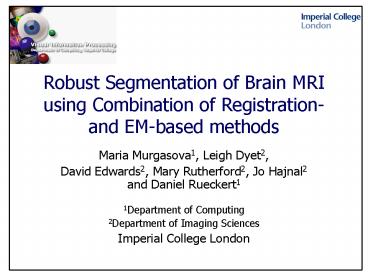Robust Segmentation of Brain MRI using Combination of Registration and EMbased methods - PowerPoint PPT Presentation
1 / 20
Title:
Robust Segmentation of Brain MRI using Combination of Registration and EMbased methods
Description:
Affine registration of probabilistic atlas. EM segmentation (Van Leemput 1999) ... Affine not always flexible enough. Non-rigid does not work. EM segmentation ... – PowerPoint PPT presentation
Number of Views:36
Avg rating:3.0/5.0
Title: Robust Segmentation of Brain MRI using Combination of Registration and EMbased methods
1
Robust Segmentation of Brain MRI using
Combination of Registration- and EM-based methods
- Maria Murgasova1, Leigh Dyet2,
- David Edwards2, Mary Rutherford2, Jo Hajnal2 and
Daniel Rueckert1 - 1Department of Computing
- 2Department of Imaging Sciences
- Imperial College London
2
Outline
- Medical background
- Registration-based segmentation
- EM-based segmentation
- Building a population-specific probabilistic
atlas - Building a subject-specific probabilistic atlas
- Comparison of the methods
3
Motivation
- The effect of premature birth
- impaired brain development
- neurological, behavioural, learning difficulties
- To understand and treat the changes we need to
measure - volumes of different brain structures
- growth of different brain structures
- This requires
- segmentation of anatomical
- structures at different time points
Brain MRI of a 2-year-old child
4
Non-rigid registration
- The aim to warp one image to another
- 3D B-spline-based registration (Rueckert 1999)
Reference subject
New subject
Affine registration
B-spline registration
5
Registration-based segmentation
- Non-rigid registration of atlas to subject
- Segmentation is warped from atlas to subject
- Advantage
- Does not assume any tissue intensity model
- gt successful in central brain structures
- Disadvantage
- Does not always deal well with complex cortical
folding
6
EM-based segmentation
- Classical model for brain MRI
- 3 basic tissue classes (WM, GM, CSF)
- Tissue intensity distributions approximately
Gaussian - Advantage
- Can capture complexity of cortex based on
intensity - Disadvantage
- Cant deal well with overlaps in tissue intensity
distributions
Real tissue distributions of 2-year-old subject
based on manual segmentation
7
EM-based segmentation
- Sub cortical structures brighter than cortical
- Overlaps cause significant difficulties
- Classical WM, GM, CSF model not sufficient for
correct segmentation
8
EM-based segmentation
- Probabilistic atlas
- Aligned with the image
- Spatially constrains the segmentation process
- Helps to overcome misclassification due to
overlaps in tissue intensity distributions
9
EM-based segmentation
- Affine registration of probabilistic atlas
- EM segmentation (Van Leemput 1999)
- E-step soft segmentation
- M-step Gaussian tissue intensity distribution
10
Application of EM to young children
- Shape of brain in young children different from
adults - White matter overestimated in sub-cortical area
- Requires a specific atlas for young children
Segmentation of 1-year-old
Adult
Adult atlas
1-year-old
11
Creating a population-specific atlas
- Start with 1 manual segmentation
Training images
Reference subject
Probabilistic atlas
Reference subject
Affine registration
Non-rigid registration
Average segmentations
12
Segmentation results
- Improvement in thalamus
- 1.0T brain MRI of a 2-year-old child
Image
Manual segmentation
EM with the adult atlas
EM with the new atlas
13
Limitations
- Registration of atlas to image
- Affine not always flexible enough
- Non-rigid does not work
Brain with a very different shape (focal lesions)
EM segmentation into 11 structures
14
Creating a subject-specific atlas
- Start with 1 manual segmentation
Training images
New subject
Probabilistic atlas
Reference subject
Non-rigid registration
Non-rigid registration
Average segmentations
15
Robust registration-based segmentation
- Subject-specific atlas can be used as a final
segmentation - Improvement over registration-based segmentation
- Some loss of detail
Registration-based segmentation
Robust registration-based segmentation
16
Robust EM-based segmentation
- Subject-specific atlas as prior information
- Correct structure boundaries
- More detail included in segmentation
EM-based segmentation
Robust EM-based segmentation
17
Robust EM-based segmentation
- Successful on brains with significantly different
shape - Example focal lesions
Robust EM-based segmentation into 11 structures
Failed EM-based segmentation into 3 structures
18
Validation
- 4 subjects 5 slices
- Dice metrics
- Agreement between manual and automatic
segmentation - Tman set of samples in manual segmentation
- Taut set of samples in automatic segmentation
19
Acknowledgements
- This work is funded by
20
(No Transcript)































